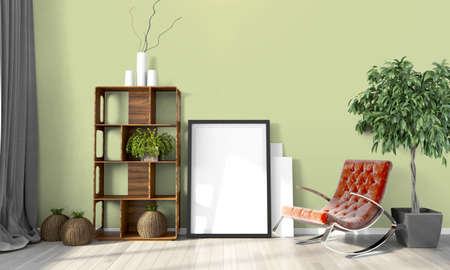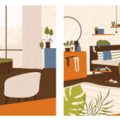Understanding Your Flat’s Unique Character
When it comes to choosing between built-in and freestanding storage, it’s essential to begin with a deep appreciation of your British flat’s individual character. From the soaring ceilings and ornate cornices found in Victorian conversions, to the clean lines and open layouts of contemporary new-builds, every flat in the UK tells its own story. These architectural quirks aren’t just charming—they directly influence how you approach storage solutions.
Older flats, particularly those carved from period townhouses, often feature alcoves, bay windows, and uneven walls that invite bespoke built-in joinery. A custom wardrobe or fitted shelving can hug these idiosyncratic spaces, making use of every inch and preserving the elegance of original features. In contrast, modern developments tend to offer boxier, more uniform rooms where sleek freestanding pieces might add flexibility without compromising flow or light.
Understanding these nuances is the foundation for any storage decision. Whether you’re nestled in a Georgian terrace in Bath or living high above London in a glass-fronted apartment, respecting the unique bones of your home ensures your storage not only fits but enhances your space—a crucial consideration when blending style with practicality in true British fashion.
2. Defining Built-In and Freestanding Storage
When reimagining storage solutions for your British flat, it’s essential to understand the fundamental distinctions between built-in and freestanding options. Both approaches offer unique advantages and can dramatically alter the feel and function of your living space. Let’s clarify these differences with a nod to classic British joinery and modern design preferences.
Bespoke Built-In Joinery
Built-in storage refers to units that are custom-designed and fitted seamlessly into the architecture of your home. In the UK, this tradition is epitomised by bespoke wardrobes nestled into Victorian alcoves or elegantly panelled cupboards under period staircases. These solutions are tailored to maximise awkward corners or high ceilings typical in British flats, making every inch count.
Freestanding Pieces
In contrast, freestanding furniture includes wardrobes, chests, and shelving units that stand alone and can be moved or replaced with ease. Think of an antique armoire handed down through generations, or a sleek, contemporary open shelving unit displaying curated ceramics and well-thumbed paperbacks—these pieces bring flexibility and personality to your space.
Key Differences at a Glance
| Aspect | Built-In Storage | Freestanding Storage |
|---|---|---|
| Design & Fit | Custom-made; fits specific dimensions | Ready-made; standard sizes |
| Style Reference | Classic British alcove wardrobes, integrated shelving | Victorian armoires, contemporary open shelves |
| Flexibility | Permanently fixed; part of property | Easily movable or replaceable |
| Adds Value? | Often increases property value in the UK market | Does not typically add to property value |
| Aesthetic Impact | Sleek, seamless appearance; blends with room architecture | Makes a style statement; can be eclectic or bold |
The choice between built-in joinery and freestanding pieces should reflect both your practical requirements and your vision for your British flat’s character. Whether you lean towards bespoke craftsmanship or crave versatility in design, understanding these core differences is key to creating a beautifully organised home.

3. Space Considerations in British Homes
When it comes to city living, British flats are renowned for their clever use of limited space. Maximising every square inch is not just a design preference—it’s often a necessity due to the compact nature of UK properties. This makes the choice between built-in and freestanding storage particularly significant for maintaining both function and flow within your home.
Built-In Storage: Seamless Integration
Built-in storage solutions, such as fitted wardrobes or custom shelving, are tailored to fit awkward alcoves and underutilised corners often found in period conversions or new-build flats alike. By hugging the contours of your flat, these units help avoid dead space and create an uncluttered, streamlined look. This can be especially valuable in London townhouses or Victorian terraces, where odd angles and chimney breasts are common architectural features. The seamless integration of built-in storage enhances room flow, making even small spaces feel more expansive and organised.
Freestanding Storage: Flexible Functionality
On the other hand, freestanding furniture brings flexibility—ideal if you’re renting or enjoy frequently refreshing your décor. British high streets and boutique shops offer everything from classic oak chests to contemporary metal shelving units that can be easily repositioned as your needs change. However, while freestanding pieces add character and are easier to take with you when you move, they may intrude into walkways or make rooms feel cramped if not chosen thoughtfully.
Balancing Room Flow and Practicality
The key in any British flat is achieving a balance between practicality and spatial harmony. Built-ins can maximise vertical space and maintain an open feel, while select freestanding items offer adaptability without overwhelming the room. Careful planning ensures your storage enhances everyday life—whether you’re enjoying a cosy night in or hosting friends for afternoon tea.
4. Style and Heritage: Blending Storage with British Décor
When selecting between built-in and freestanding storage for your British flat, it’s essential to honour the character and heritage of your home. Many British properties feature charming period details—such as ornate fireplaces, decorative coving, or original timber flooring—that serve as a backdrop to both modern life and timeless style. The key is to integrate storage solutions that complement rather than compete with these unique elements.
Highlighting Period Features
Built-in storage can be expertly designed to frame and accentuate architectural gems like alcoves, sash windows, or chimney breasts. For instance, custom joinery fitted into alcoves on either side of a fireplace provides seamless symmetry while offering ample space for books or treasured objects. Conversely, freestanding pieces can also work well when chosen with respect for scale and proportion; a classic oak cabinet might echo Victorian sensibilities without overwhelming delicate cornicing.
Balancing Functionality and Aesthetics
It’s crucial to strike the right balance between practical storage needs and preserving the integrity of British interior aesthetics. Built-ins are often finished in muted heritage colours—think Farrow & Balls ‘Hague Blue’ or ‘Ammonite’—to blend subtly with period palettes. Freestanding furniture offers flexibility; you can mix eras by placing a mid-century sideboard beneath an Edwardian picture rail for eclectic charm.
Complementing Fireplaces and Coving: Comparison Table
| Built-In Storage | Freestanding Storage | |
|---|---|---|
| Fireplaces | Bespoke shelving or cabinetry flanking the hearth, maintaining sightlines to ornate mantels | Low chests or consoles placed at a respectful distance from the fireplace to avoid crowding focal points |
| Coving & Cornicing | Tall units measured precisely to stop below decorative plasterwork, preserving ceiling detail | Slim wardrobes or armoires that sit clear of coving, highlighting architectural features above |
| Period Colour Schemes | Painted in soft whites, sage greens, or deep blues to reflect traditional British interiors | Natural woods or painted finishes that echo historical tones but allow for seasonal updates |
Sensitive Integration Tips:
- Opt for panelled doors and mouldings on built-ins to mirror original joinery.
- Choose freestanding pieces with turned legs or brass fittings for a vintage touch.
- Avoid obstructing light from bay windows by keeping storage low-profile in such areas.
- If unsure, consult a local carpenter experienced in period properties for bespoke advice.
Ultimately, weaving together practicality and period charm allows your storage choices to feel like a natural extension of your flat’s history—honouring the past while embracing present-day living needs.
5. Budget, Flexibility, and Long-term Value
When it comes to choosing between built-in and freestanding storage for your British flat, understanding the interplay between budget, flexibility, and long-term value is essential—especially in the context of the UK’s dynamic property market.
Cost Considerations
For many renters and first-time buyers across Britain, budget remains a leading factor. Freestanding storage solutions generally require a lower upfront investment; flat-pack wardrobes or bookcases from high street retailers are both affordable and easy to update as needs change. In contrast, built-in options are often seen as a larger financial commitment, involving bespoke joinery and professional installation. However, while initial costs can be steeper, built-ins may ultimately add tangible value to your home.
Adaptability & Lifestyle Changes
The British rental sector is vibrant and transient, with many tenants favouring flexibility. Freestanding furniture suits those who move frequently or anticipate changing room layouts. You can take your chest of drawers or modular shelving with you from a Victorian terrace in Manchester to a modern flat in London. Conversely, built-ins are tailored to specific spaces—perfect for maximising awkward alcoves or under-eave nooks commonly found in period properties but less adaptable if you decide to relocate.
Long-term Value & Resale Impact
For homeowners looking to settle down or increase their property’s market appeal, investing in built-in storage can be a wise decision. Estate agents across the UK often highlight quality fitted wardrobes or bespoke cabinetry as attractive selling points, especially in urban areas where space is at a premium. Well-designed built-ins not only enhance day-to-day living but can also yield a higher resale price when it’s time to move on. On the other hand, freestanding pieces offer little influence on property value but provide personalisation and convenience for short-term stays.
Balancing Priorities in Your Flat
Ultimately, your choice should reflect your unique circumstances: weigh immediate costs against future benefits, consider how often you might move, and think about whether youre seeking personal expression or long-lasting investment. The right balance will help ensure your British flat remains both stylish and practical—whatever stage of life you’re in.
6. Making the Decision: What’s Right for You?
When it comes to choosing between built-in and freestanding storage for your British flat, the decision is all about matching your lifestyle, space constraints, and design preferences. Here are some practical tips to guide you through the process:
Assess Your Space
British flats often feature compact rooms and unique architectural quirks, such as alcoves or bay windows. Take precise measurements and consider how each option would interact with these features. Built-in storage can be tailored to awkward nooks, maximising every inch, while freestanding pieces offer flexibility if you plan on rearranging your layout or moving home in the near future.
Consider Your Tenancy and Future Plans
If you’re renting or anticipate moving frequently—a common scenario in UK cities—freestanding storage might be preferable, as it’s portable and won’t require landlord approval. For homeowners seeking a long-term solution, investing in bespoke built-ins can add value and create a seamless look that complements period detailing or contemporary finishes.
Think About Aesthetics and Functionality
Evaluate your design vision. Do you prefer a streamlined, minimal look? Built-ins can make a room feel more open by reducing visual clutter. If you enjoy changing up your décor or collecting eclectic pieces from markets across Britain, freestanding furniture lets you adapt your style seasonally or with new finds.
Budget Wisely
Built-in solutions typically come at a higher upfront cost but may offer better long-term value, especially in London where space is at a premium. Freestanding options suit tighter budgets and allow you to upgrade gradually without a major financial commitment.
Key Questions to Ask Yourself
- How long do I plan to stay in this flat?
- Am I allowed to make structural changes?
- Do I need maximum storage capacity or more flexibility?
- What is my budget both now and over time?
No matter which route you choose, thoughtful planning ensures your storage not only serves its practical purpose but also enhances the charm and functionality of your British flat. Remember: it’s not just about storage—it’s about creating a space that feels like home.


